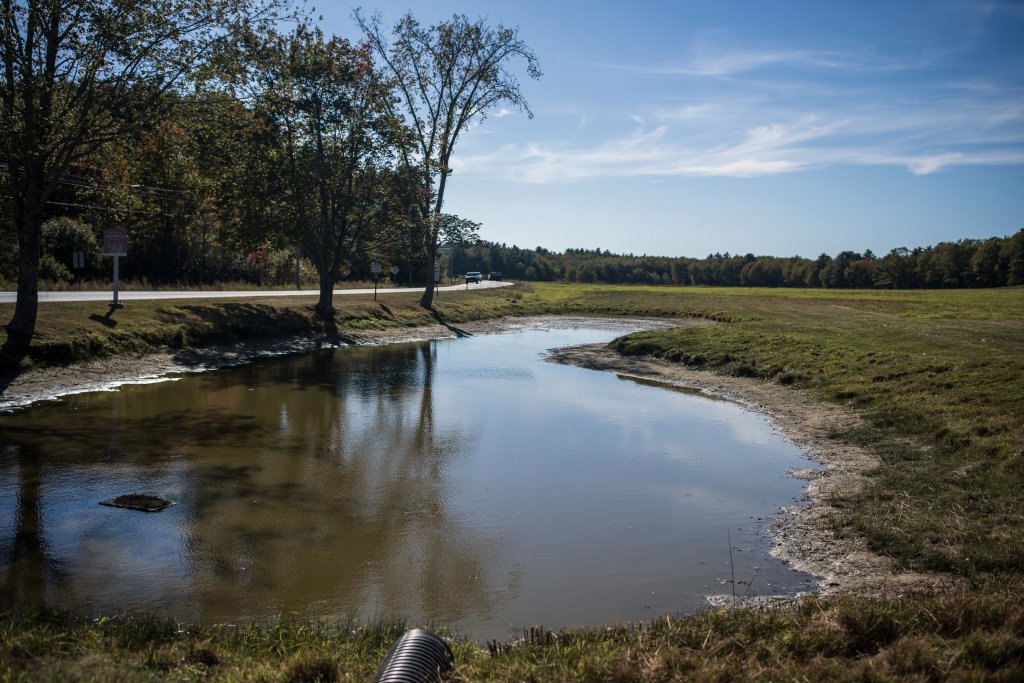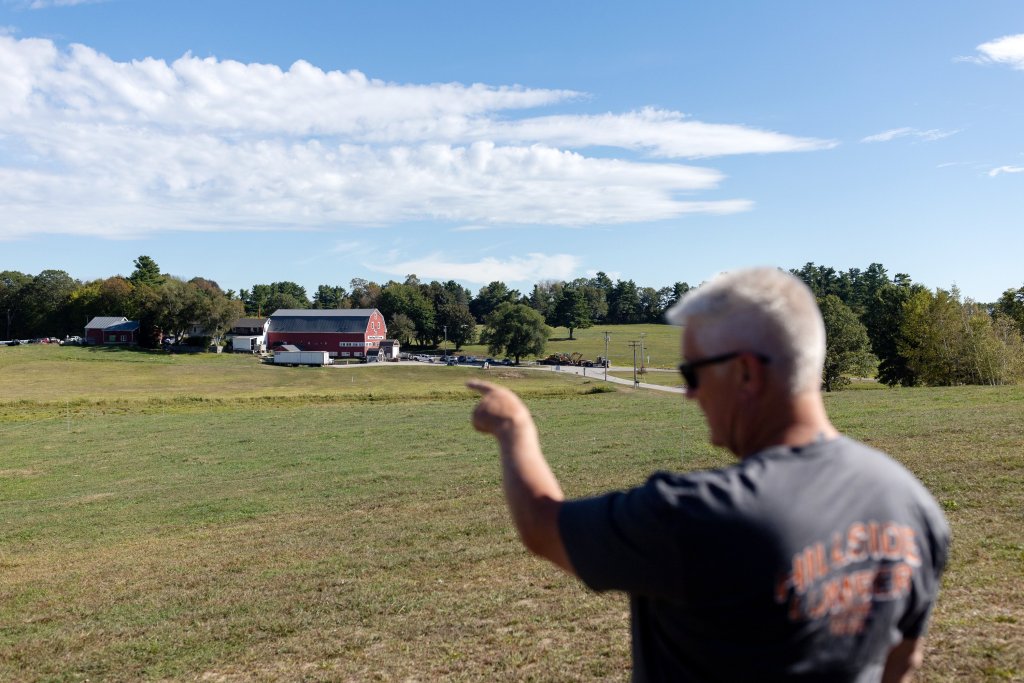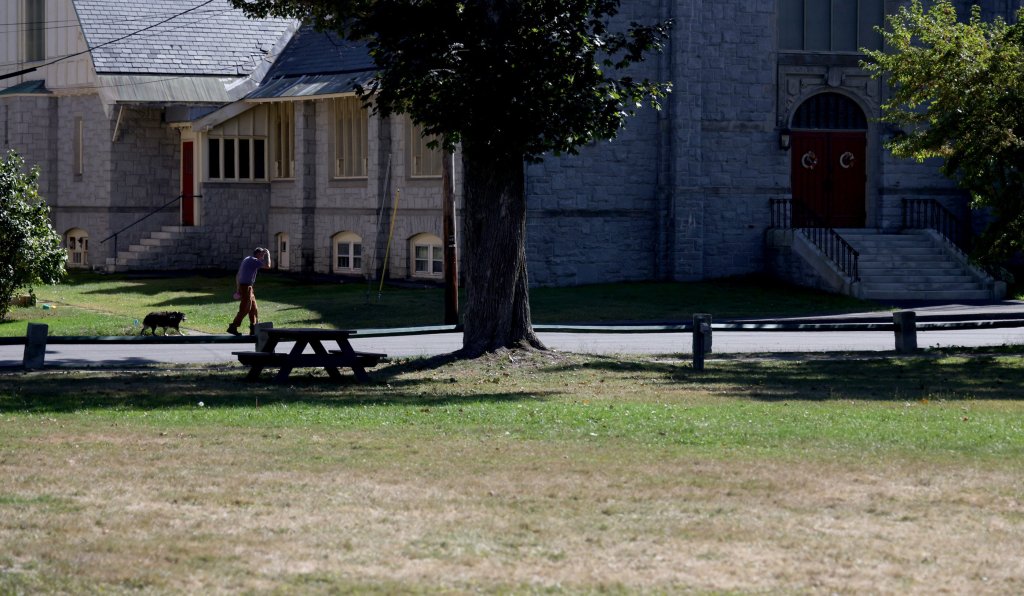
In more than six decades living and working on Smiling Hall Farm, Michael Knight has never seen the pond so dry.
“I call it ‘low tide,’ because I’ve never seen it so low that the mud is showing,” Knight, who co-owns the farm, said Thursday morning. “It looks like a puddle now.”
Smiling Hill, like most of Maine, has braved worsening drought conditions for weeks. A stretch of hot and dry days has browned grassy fields, threatened the fall foliage’s usual brilliance and sucked the water out of wells from Canada to the coast. And, forecasters say, it’s not clear when conditions may improve.
More than 5% of Maine is now in extreme drought conditions, and nearly two-thirds of the state is in some degree of drought, according to data released Thursday by the U.S. Drought Monitor. The data reflects conditions as of Tuesday.
About 58% of the state is now classified as being in an severe drought, which is one level below extreme. That includes all of southern, central and Down East Maine — including the state’s entire coastline, from Kittery to Eastport.
Areas experiencing extreme drought conditions include parts of Oxford, Franklin, Androscoggin, Cumberland, Somerset and Kennebec counties.
In a severe drought, air and water quality are typically poor, groundwater levels drop and irrigation ponds run dry. Some crops are affected in both yield and size, warnings are issued regarding outdoor burning, golf courses begin to conserve water and trees become brittle, according to the drought monitor.
As conditions deteriorate into an extreme drought, crop loss becomes widespread and dairy farms begin to struggle, according to the drought monitor. Rivers run shallow and warm, and wells run dry.
CHANGING PASTURES, CHANGING COLORS
With so little rain, the grassy pastures at Smiling Hill are unable to grow quickly enough to keep up with grazing cattle, Knight said. Usually, the farm’s dozens of cows can graze in the same field all summer: a spot just in front of the main barn.

“If we had the rain, that particular pasture would take care of the cows for the summer and the fall and so forth,” Knight said. But this season’s grazing area is “much larger than it’s ever been.”
That has also meant limited hay yields, as the grass is unable to grow tall and brown, he said.
Caleb Goossen, a crops specialist at the Maine Organic Farmers and Gardeners Association, said that established farms generally have a few sources of water to draw from if things dry up. Plus, drought conditions can also kill fungal spores that might otherwise bring disease, he said.
“If (growers) are experienced and they have the understanding of when crops need water and how to deliver it well — and the water supply is well matched to their need — then this could actually be a banner year for them,” Goossen said.
But drought can be particularly punishing for growers with limited water, especially those who are new to farming.
“They’re already scrambling to build up their infrastructure in the first place. They may not have one consistent water supply, let alone a redundancy,” Goossen said.
Beyond agriculture, the drought could threaten Maine’s typically vibrant fall foliage, which is usually triggered by cool nights, shorter days and heightened rainfall.

Each year, the Maine Department of Agriculture, Conservation and Forestry publishes a weekly foliage report, outlining color changes throughout the state. As of Wednesday’s report, Maine’s coast had seen very little change in colors, while most of the state saw between 10% and 30% of leaves changing.
Northern Maine is expected to reach its peak for foliage season between the last week of September and the first week of October, the department said. The rest of the state typically peaks by mid-October.
Gale Ross, the department’s foliage spokesperson, said that despite concerns earlier in the season, this year appears to be following historic trends. She said a recent string of cooler nights has helped coax color from the leaves, and emphasized that “it really is all about our weather going forward.”
“(The drought) may shorten the season, and, as I’ve said, it could temper down the brilliance in the leaves,” Ross said on a Thursday afternoon phone call. “But my perspective right now: We look like we are really just on track for a beautiful fall foliage season.”

IMMEDIATE RELIEF UNLIKELY
Maine could see some rain in the second half of next week, but it’s too early to say whether it will be the wetting downpours the state desperately needs or just showers, said Jerry Combs, a meteorologist at the National Weather Service office in Gray.
In the meantime, the weekend is likely to bring low temperatures and low humidity levels — and not much rain.
“Pretty much little to no precipitation through at least Monday, and that may continue into Tuesday,” Combs said Thursday morning. “It’s going to continue to be very dry. Clouds are going to be few and far between, if any at all.”
Fire danger is high throughout the state, the Department of Agriculture, Conservation and Forestry reported Thursday morning. Old Orchard Beach announced a fire ban shortly after noon Thursday.
Drought conditions flared up suddenly in August, spurred by weeks of extreme heat and dry weather. Nearly 1.2 million Mainers live in drought-stricken areas, according to the monitor.

We invite you to add your comments. We encourage a thoughtful exchange of ideas and information on this website. By joining the conversation, you are agreeing to our commenting policy and terms of use. More information is found on our FAQs. You can modify your screen name here.
Comments are managed by our staff during regular business hours Monday through Friday as well as limited hours on Saturday and Sunday. Comments held for moderation outside of those hours may take longer to approve.
Join the Conversation
Please sign into your CentralMaine.com account to participate in conversations below. If you do not have an account, you can register or subscribe. Questions? Please see our FAQs.